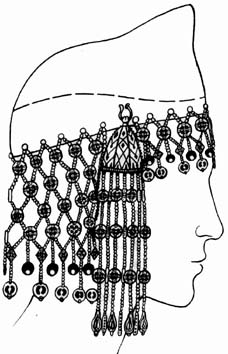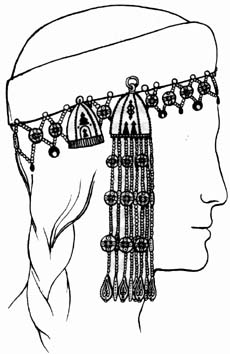Units of measurement that may be important:
1 glass = slightly less than 1 US liquid cup
1 spoon = between 3.2 and 3.6 US tablespoons
-->
Apricot dinner kasha:
3 to 4 cups water
1 cup bulgar
2 carrots, diced
1 onion, diced
1/4 cup of prunes, dried apricots, raisins or other dried fruit cut up
salt to taste
Bring water to boil and stir in bulgar, onion, and carrot. Simmer over low heat, stirring every 15 minutes until the desired texture, approximately 45 minutes (watch carefully so it doesn't burn). Add the apricots toward the end of cooking. Add extra water if needed.
Shashlyk:
Marinade for 5 lb meat (lamb or beef): 1-2 onions, coarsely chopped
2 bay leaves
2 clove garlic
Pepper corns
2 cups pomegranate juice
Layer cubed meat with onion and spices. Top layer should be onion. Pour pomegranate juice over the meat. Freeze or marinate in fridge. Grill to desired done-ness.
1 large onion, chopped
1 medium cabbage (chopped)
Salt and pepper to taste
Enough pie crust for five 9-inch pies.
Saute onion in a large pot until soft and translucent. Add the cabbage and cook covered until soft. Add salt and pepper to taste. Roll out a crust and put into a pie tin. Put cabbage mixture on one half of circle. Fold over other half of dough to form a large turnover and seal the edge, leaving half the pie tin free to hold another pie. This recipe should make 5 pies. Bake in preheated 400 degree oven about 30 minutes or until golden brown.
2 1/2 cups whole wheat flour
1 teaspoon sea salt
1 cup water
Mix ingredients with hands. Turn dough onto a floured
work surface and knead for 5 minutes.
Transfer to a bowl and
cover tightly with plastic wrap. Let dough rest for 30 to
90 minutes. Divide dough into 8 equal
pieces. Roll each piece into a
7-inch (18-cm) circle. Spray a cast-iron griddle
or skillet once with cooking spray and set over medium-low heat. Cook for 1
minute. Turn over and cook 5
minutes on second side or until bread bubbles up. Flip back to first side
and cook for 5 minutes.
Marinovannye Griby:
(Pickled Mushrooms)
1c red wine vinegar
2 whole cloves
½ c cold water
5 whole peppercorns
½ bay leaf
2 tsp salt
2 cloves garlic
1 lb mushrooms
1 tbsp vegetable oil
Combine vinegar, cloves,
water, pepper, bay leaf, salt and garlic in a pan. Heat over high
heat to boil and drop in mushrooms. Reduce heat and simmer for 10
minutes. Remove garlic from marinade and pour contents of pan into 1
quart jar. Pour oil over top. Place plastic wrap over top and cover
jar tightly. Let marinate about one week.
Hen with prunes:
1 large hen (or equivalent
of chicken)
2 spoons butter
1 carrot
1 parsley root
1 onion
2-3 bay leaves
1 spoon flour
vinegar or ½ a lemon
1-2 pieces of sugar
½ lb prunes
10-15 allspice
Clean and salt hen. Place
¼ lb butter, root vegetables, and spices in a stew pan. When butter
starts to bubble, add the hen and stew, covered, until tender,
turning and adding a little water. When cooked, remove and cut into
pieces. Return to pan and add 3 glasses (a little less than 3 cups) bouillon – cook for ½ an
hour.
Meanwhile, fry 1 spoon (3.5 tablespoons)
flour in butter, dilute with hen bouillon and add vinegar and sugar.
Bring sauce to boil, strain, pour over hen. Add prunes that have been
boiled in water, covered, left to stand 1-1 ½ hours, and removed
from water with a slotted spoon. Bring everything to a boil. Serve
chicken and prunes with a little sauce on top and rest of sauce separately.
Turnip pudding with ham:
2 1/12 spoons butter
6 eggs
2lbs turnips
½ lb ham
1/6 lb cheese
½ spoon butter
Cream ¼ lb butter until
white. Beat in 3 eggs and 3 egg yolks and 1 ½ glass mashed/boiled
turnips and 1/2lb finely chopped ham. Mix thoroughly and pile into a
mold greased with butter. Set in oven and, when pudding is ready,
turn it out onto a platter. Strew with cheese and pour on hot butter.
(Can be made easily without the ham and is well received.)
(Can be made easily without the ham and is well received.)
Mushroom Caviar:
12oz mushrooms finely
chopped
1 medium onion finely
chopped
4 oz butter
1 tbsp dry sherry
3 oz curd cheese
3 oz cream cheese
2 oz parsley
1 oz tarragon
1 oz marjoram
Saute mushrooms and onion
in butter. Once soft, add sherry and remove from heat. In a bowl beat
together cheeses and herbs. Stir in mushrooms, onion, and juices.
Beat until combined and transfer into a crock. Chill overnight or up
to three days.
Creamed Beets:
3lbs beets
1 spoon finely chopped
onion
1 1/2 spoons butter
1/4 spoon flour
3/4 glass sour cream
salt
2-3 spoons vinegar
Boil beets. Peel and chop.
Fry onion in butter and add flour and beets. Mix. Add sour cream,
salt, and vinegar. Bring to boil. Some people add sugar or honey.
Most requested sideboard items (to continually be updated):
Shortbread
My recipe is always the same. Mix together 1 cup of flour, 1/2 cup of powdered sugar (or sugar that has been pounded in mortar/pestle or pulsed through a food processor). Rub in one stick of butter, cut into cubes, until a firm cookie dough is formed. Roll and cut or shape cookies with hands and then cook at 325 for 15-20 minutes. As shortbread is so easy to experiment with, it is no wonder I use it to make mock springerle or add various other flavors. A recent event I was at I ended up making a special type of cookie and wanted to share that recipe here:
Most requested sideboard items (to continually be updated):
Shortbread
My recipe is always the same. Mix together 1 cup of flour, 1/2 cup of powdered sugar (or sugar that has been pounded in mortar/pestle or pulsed through a food processor). Rub in one stick of butter, cut into cubes, until a firm cookie dough is formed. Roll and cut or shape cookies with hands and then cook at 325 for 15-20 minutes. As shortbread is so easy to experiment with, it is no wonder I use it to make mock springerle or add various other flavors. A recent event I was at I ended up making a special type of cookie and wanted to share that recipe here:
1 cup flour
1/2 cup powdered sugar (there was only granulated at the event, so I made do, but MUCH better with powdered)
1/2 cup (or one stick) or cold butter
1/ teaspoon orange zest
2 tablespoons lavender
pine-nuts
Sift together the flour and sugar. Add the orange zest. Cut the butter into cubes and (trust me on this) rub the butter with your fingers into the dough. When dough begins to resemble crumbs, add the lavender. Keep rubbing until a nice firm cookie dough forms. Shape however you like using cookie cutters or just shape with fingers. Decorate using the pine-nuts. Bake at 325 for 15-20 minutes until lightly golden. Cool on a rack for best results.
1/2 cup powdered sugar (there was only granulated at the event, so I made do, but MUCH better with powdered)
1/2 cup (or one stick) or cold butter
1/ teaspoon orange zest
2 tablespoons lavender
pine-nuts
Sift together the flour and sugar. Add the orange zest. Cut the butter into cubes and (trust me on this) rub the butter with your fingers into the dough. When dough begins to resemble crumbs, add the lavender. Keep rubbing until a nice firm cookie dough forms. Shape however you like using cookie cutters or just shape with fingers. Decorate using the pine-nuts. Bake at 325 for 15-20 minutes until lightly golden. Cool on a rack for best results.






